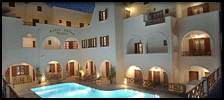
History
Human presence on the island seems to have existed from the midst of the third millennium BC. The archaeological findings at Akrotiri, which are dated before the Minoan eruption, witness the existence of a developed and likely oligarchic life on the island of Santorini, even before the Copper Ages.
The excavation of Akrotiri certifies that in the next period, the Cycladic Ages (2000-1550 BC), human activity continued. In the mid and end of the Copper ages (20th-17th Century BC) Santorini was expanded and gradually developed into one of the most important urban centres and ports. The buildings, drainage system, furniture, murals are an example of how developed it was. Some imported products, which were found in buildings demonstrate the public relations that Akrotiri had formed with Crete, the Greek mainland, The Dodecanese, Cyprus, Syria and Egupt.
In the 2nd millennium BC the volcano in Santorini erupted which sunk the island, along with the culture and values of the habitats.
The references of Herodotus mention that the island was initially calles Stroggili (round) around 1300 BC, later named Kallisti by the Finikes who were lead by Kadmos and were placed in Santorini for five generations. The island was later on colonized by the Spartians led by Thira, hence the name of the area today. Santorini has also been named through the ages Kalavria, Karisti, Tefsia, Thirameni, Rinia, Filotera and Filiteri.
The 9th century BC , Thira , Cyprus , Crete, and other Southeast areas of Greece make up the gates between the east and west, and by the beginning of the 8th Century the Finiki alphabet is introduced to Thira ( Greek alphabet derives from this alphabet).
The Archaic Period (7th and 6th Century BC) finds Thira, Crete and Paros connected, whilst a latter relationship is formed with Attica, Corinthus, Rhodes and Ionia which is only superficial as no major influences are apparent in Thira.
In the 6th Century BC the two dolphins are the formal emblem of the island, and Thira creates its own currency. The mint suspends its function during the Persian wars and only after the Athenian reign does it open again.
During the Hellenistic years, the strategic location of the island in the Aegean Sea was appraised by Ptolemeus and its natural entrenchment, turned Thira into a significant marine and military base. On the reign of Alexios Komninos the 1st (1081-1118) the temple of Panayia Episkopis was built in the area Gonia.
Following the fall of Constantinople in 1204 from the Fourth foray of the Missionaries and the creation of the Latin Empire of Vosporos , Dandolous gave the islands to his nephew, Mark Sanoudo, creating the dukedom of Naxos. Thira became the throne for one of the four Latin Eparchies of the dukedom and with Thirasia it was accorded a baronage to Iakov Varotsi. Up to 1296, the island under the title ‘Seigniory of the isles of Santorini and Thirasia’’ was under the administration of five generations of the Varotsi family.
Thira is named Santorini after the church of Agia Irini, which seems to have been in the Perissa , or the Riva area of Thirasia. Initially it was though Agia Irini was a chapel in Thirasia, however today it seems more possible that Agia Irini was a big church located in Perissa, the ruins of which were discovered in 1992.
The Varotsi family was deported in 1335 and the baronage and dukedom were merged. Under the reign of the Sanoudes, the island was developed agriculturally and wool was introduced. In the heyday of the Duke Jacob of Krispon (1397-1418), the volcano was extensively studied, while the oncoming Dukedom of Crete of Dominico Pisani reinforced agriculture and the development of vines and wool.
Finally the annexation of the island follows in 1487 to the remaining dukedom, in Venice.
Whilst under the Frankish occupation, the island was under pirate invasions, was seen as competition and became targets of the local Latin dynasties or the Duke and the Sultan whilst in the middle of catholic and orthodox tensions.
The Turkish invasion (1579-1821) was an important period for the fight against piracy and commercial development. There were close bonds created with huge ports such as the Alexandria port, Constantinople and the Eastern Mediterranean, as well as significant colony establishments. The economic independence of that era is still visible today in villages of Santorini.
In 1821 Santorini participated with her navy at the revolution, and in 1830 was integrated into the free Hellenic state. Development in all areas follows until the earthquake of 1956, which brought the island to a developmental standstill up until the late 70s when tourism began to blossom.
Useful Info
 Shopping
Shopping Architecture
Architecture Entertainment
Entertainment Food
Food The Volcano
The Volcano History
History Morals and customs
Morals and customs Beach
Beach Access
Access Transportation
Transportation Useful Info
Useful Info Local Products
Local Products


